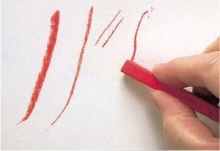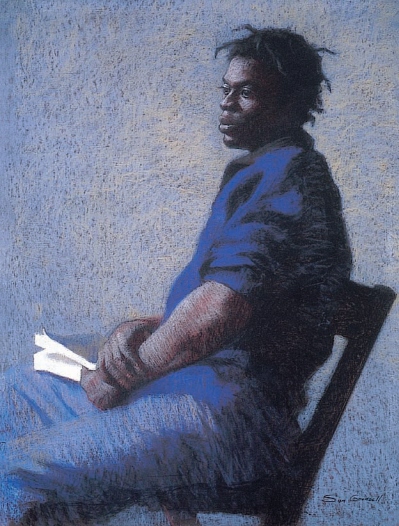
making strokes
Applying pastel to paper is as simple as picking up a stick and making a mark. Unlike wet mediums, there’s no need to mix a color—just select one and go! However, there are many ways of making those marks, as you’ll discover as you experiment with these methods and others you’ll develop on your own. There’s no “wrong” way to use pastels, so don’t hesitate to try whatever you think might work.
How you hold the stick—point down, on edge, on its side—affects how the mark or stroke appears. Varying pressure also affects the appearance of the mark as well as the coverage or even the color on the paper. Trying these techniques will help you understand the feeling of the strokes as well as the results.

varying the pressure
Harder or firmer pastels can be used for drawing lines and making small strokes. If you vary the pressure as you make the mark, you can create thick or thin strokes. The pastel used here is from the Faber-Castell Polychromos set.

holding pastels on their side
When you hold a pastel stick on its side, you create a wide stroke. Again, varying the pressure allows you to lightly glaze or heavily apply a layer of color over the surface.

crosshatching
Use crosshatching to cover a surface with strokes in two directions. This method is particularly effective if you’re working on a surface with very little tooth, such as the Canson Mi-Teintes paper shown here. You’ll be able to get a nice, solid color without over-filling the grain of the paper.

weaving lines
Weaving lines can be used to cover the surface with multiple colors in random directions. Unlike cross-hatching, this creates a varied and somewhat textural surface, and you can use as many colors as your surface will allow. This technique lets you build exciting colors up on areas that might otherwise be flat and boring if painted with a single color.

rolling strokes
Using a rolling stroke with a round, soft pastel creates an uneven line. This is useful when your subject includes things like reeds or grasses or even tree branches—the rolling stroke keeps you from getting too repetitive and regular—and it’s fun to do.

pastel pencils
Very fine lines can be created with pastel pencils. They’re especially useful for thin, sharp lines; for example, you might use them to place thin branches over an already-painted sky. But be careful not to overuse them: Your painting could look more like a drawing, or have too much detail.

Madrid at Dusk
9" × 12" (23cm × 30cm) by Desmond O’Hagan
layering to create texture
Desmond O’Hagan uses layering to create texture, varying the pressure as he applies the color. Lighter pressure applies a ˝skim˝ of color, while a heavier pressure applies a more intense, heavy coverage.

Knowledge is Power
40" × 30" (102cm × 76cm) by Sam Goodsell
variety of strokes
Sam Goodsell uses a variety of strokes and lines to create the form. Note that some of his strokes, rather than being broad passages of color created with the sides of the pastels, are more linear, and the weaving and layering of the lines and small strokes create the form.